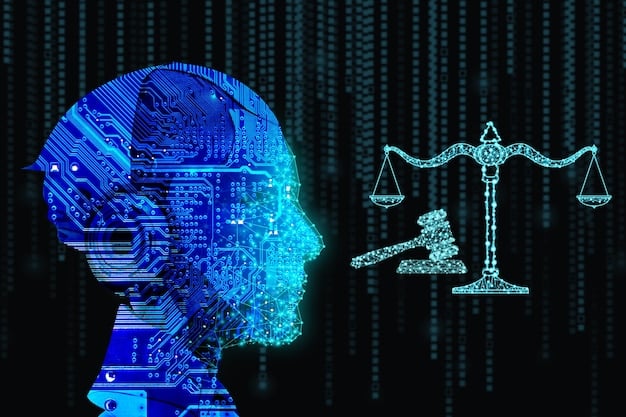AI in Criminal Justice: Bias Mitigation and Fairness in US Courts

AI and Criminal Justice: Addressing Bias and Ensuring Fairness in US Courts examines how artificial intelligence is transforming the US legal system, highlighting the crucial need to identify and mitigate biases to ensure equitable outcomes for all.
The integration of artificial intelligence into the criminal justice system holds both immense promise and potential pitfalls. While AI offers the possibility of increased efficiency and data-driven decision-making, it also raises concerns about perpetuating and amplifying existing biases. This article, titled AI and Criminal Justice: Addressing Bias and Ensuring Fairness in US Courts, delves into these challenges and explores strategies for ensuring equitable justice in the age of AI.
The Rise of AI in US Criminal Justice
Artificial intelligence is rapidly changing various sectors, and the legal field is no exception. From predictive policing to risk assessment tools used during sentencing, AI algorithms are increasingly involved in critical decisions within the US criminal justice system. Understanding the scope of this technological integration is crucial to addressing its ethical and practical implications.
Current Applications of AI
AI is being deployed in several areas of criminal justice, impacting almost every stage of the legal process. Law enforcement agencies are using AI for crime prediction, courts use it for risk assessment, and correctional facilities use it for monitoring inmates.
- Predictive Policing: AI analyzes historical crime data to forecast potential hotspots and allocate resources accordingly.
- Risk Assessment: Algorithms assess the likelihood of a defendant re-offending, influencing decisions about bail and sentencing.
- Facial Recognition: Law enforcement uses facial recognition technology to identify suspects and track individuals.
These applications aim to improve efficiency and accuracy. However, they also introduce complex challenges, particularly regarding bias and fairness.

Potential Benefits and Drawbacks
While the promise of AI in criminal justice includes heightened efficiency and more data-driven decisions, there are also potential pitfalls that could undermine the goals of fairness and justice.
- Benefits: Increased efficiency, reduced human error, data-driven predictions.
- Drawbacks: Algorithmic bias, lack of transparency, potential for discrimination.
- Ethical Concerns: Impacts on privacy, civil liberties, and due process.
A balanced approach is needed to harness AI’s benefits while mitigating its potential harms. This requires careful consideration of the ethical and legal implications and a commitment to ensuring fairness and transparency.
As AI continues to integrate into the criminal justice system, it is essential to critically evaluate its impact on fairness and equity. By understanding both the potential benefits and drawbacks, stakeholders can work towards responsible implementation.
Identifying Bias in AI Algorithms
One of the most significant concerns surrounding AI in criminal justice is the potential for algorithmic bias. These biases can arise from various sources and can have far-reaching consequences, particularly for marginalized communities. Identifying and understanding these biases is the first step toward mitigating their harmful effects.
Sources of Algorithmic Bias
Algorithmic bias can stem from several sources, including biased training data, flawed algorithm design, and the perpetuation of existing societal biases. These biases can infiltrate AI systems at various stages of development and deployment.
- Biased Training Data: AI algorithms learn from historical data, which often reflects existing societal biases. If this data is skewed, the algorithm will likely perpetuate and amplify these biases.
- Flawed Algorithm Design: The way an algorithm is designed and structured can inadvertently introduce bias. For instance, the selection of certain variables or the weighting of different factors can lead to discriminatory outcomes.
- Feedback Loops: AI systems can create feedback loops, where biased decisions reinforce themselves over time. This can result in a cycle of perpetuation and amplification of biases.
Addressing these sources of bias requires a multi-faceted approach, including data auditing, algorithm redesign, and ongoing monitoring.
Examples of Biased AI Systems
Several high-profile cases have highlighted the potential for bias in AI systems used in criminal justice. These examples underscore the urgent need for greater scrutiny and regulation of AI in the legal system.

- COMPAS: The Correctional Offender Management Profiling for Alternative Sanctions (COMPAS) algorithm has been shown to disproportionately misclassify Black defendants as high-risk, even when compared to white defendants with similar criminal histories.
- Facial Recognition Systems: Facial recognition technology has been found to be less accurate in identifying individuals with darker skin tones, leading to higher rates of misidentification and wrongful arrests.
- Predictive Policing Algorithms: If trained on historical data that reflects biased policing practices, these algorithms can reinforce discriminatory policing patterns, leading to over-policing in already marginalized communities.
These examples serve as cautionary tales, emphasizing the importance of rigorous testing and validation to identify and correct biases in AI systems.
Identifying and understanding the sources of algorithmic bias is essential to ensuring fairness in criminal justice. By recognizing the potential for bias in training data, algorithm design, and feedback loops, stakeholders can take proactive steps to mitigate these harms.
Ensuring Fairness and Transparency in AI Applications
To mitigate the risks associated with AI in criminal justice, it is crucial to prioritize fairness and transparency. This involves implementing best practices for algorithm development and deployment and establishing mechanisms for accountability and oversight.
Best Practices for Algorithm Development
Fairness and transparency should be central considerations throughout the algorithm development process. This includes selecting diverse and representative training data, employing fairness-aware algorithm design techniques, and conducting rigorous testing and validation.
- Diverse Training Data: Ensuring that training data is representative of the population it will be applied to is crucial to reducing bias. This may involve collecting additional data from underrepresented groups or using techniques like data augmentation to balance the dataset.
- Fairness-Aware Algorithm Design: Incorporating fairness metrics into the algorithm design process can help to ensure that AI systems do not perpetuate or amplify existing biases. This may involve using techniques like disparate impact analysis and fairness-aware optimization.
- Rigorous Testing and Validation: Thorough testing and validation are essential to identifying and correcting biases in AI systems. This should include testing on diverse subpopulations and evaluating the algorithm’s performance across different fairness metrics.
By following these best practices, developers can create AI systems that are more equitable and less likely to produce discriminatory outcomes.
Implementing Transparency and Accountability
Transparency and accountability are essential to building trust in AI systems used in criminal justice. This involves providing clear and understandable explanations of how algorithms work, establishing mechanisms for appealing decisions made by AI, and holding developers and deployers accountable for ensuring fairness.
- Explainable AI (XAI): Making AI systems more transparent and explainable can help to build trust and facilitate oversight. XAI techniques help to provide insights into how algorithms work and why they make certain decisions.
- Appeals Mechanisms: Individuals should have the right to appeal decisions made by AI systems, particularly when those decisions affect their liberty or well-being. This requires establishing clear and accessible appeals processes.
- Accountability and Oversight: Developers and deployers of AI systems should be held accountable for ensuring fairness and compliance with ethical standards. This may involve establishing regulatory frameworks and independent oversight bodies.
By prioritizing transparency and accountability, stakeholders can ensure that AI systems are used responsibly and ethically in criminal justice.
Ensuring fairness and transparency in AI applications is critical to mitigating the risks associated with algorithmic bias. By implementing best practices for algorithm development and establishing mechanisms for accountability and oversight, stakeholders can promote the responsible and ethical use of AI in criminal justice.
The Role of Policy and Regulation
To effectively address the challenges posed by AI in criminal justice, it is essential to develop appropriate policies and regulations. These policies should aim to promote fairness, transparency, and accountability while also fostering innovation and technological progress.
Current Regulatory Landscape
The regulatory landscape for AI in criminal justice is still evolving. While some jurisdictions have started to implement regulations governing the use of AI in law enforcement and courts, there is no comprehensive federal framework addressing these issues.
- State and Local Regulations: Some states and cities have enacted laws regulating the use of facial recognition technology and other AI applications in law enforcement. These regulations often focus on transparency, accountability, and protection of civil liberties.
- Federal Initiatives: At the federal level, there have been discussions about establishing a national AI strategy and creating guidelines for the responsible development and deployment of AI technologies. However, these efforts are still in the early stages.
- International Standards: International organizations like the United Nations and the European Union have been developing ethical guidelines and regulatory frameworks for AI. These standards may influence the development of policies in the US.
As AI continues to advance, it is crucial to establish clear and consistent regulatory standards to ensure responsible innovation and protect the rights of individuals.
Recommendations for Effective Policy
To promote the responsible use of AI in criminal justice, policymakers should consider implementing the following recommendations:
- Establish Independent Oversight Bodies: Create independent oversight bodies to review and monitor the use of AI systems in law enforcement and courts. These bodies should have the authority to investigate complaints, conduct audits, and make recommendations for improvement.
- Require Transparency and Explainability: Mandate that AI systems used in criminal justice are transparent and explainable. This includes providing clear and understandable explanations of how algorithms work and why they make certain decisions.
- Implement Fairness Testing and Auditing: Require regular fairness testing and auditing of AI systems to identify and correct biases. These audits should be conducted by independent experts and the results should be made public.
- Protect Civil Liberties and Privacy: Ensure that AI systems are used in a manner that protects civil liberties and privacy rights. This may involve implementing safeguards to prevent the misuse of data and limiting the scope of AI surveillance.
By adopting these policies, policymakers can help to ensure that AI is used responsibly and ethically in criminal justice.
The role of policy and regulation is critical to ensuring that AI is used fairly and ethically in criminal justice. By establishing clear and consistent regulatory standards and implementing effective oversight mechanisms, policymakers can promote responsible innovation and protect the rights of individuals.
Case Studies: AI in Action and Lessons Learned
Examining real-world case studies of AI deployment in criminal justice can provide valuable insights and lessons learned. These examples illustrate both the potential benefits and potential pitfalls of using AI in the legal system.
COMPAS: A Cautionary Tale
The Correctional Offender Management Profiling for Alternative Sanctions (COMPAS) algorithm is one of the most well-known examples of AI used in criminal justice. However, it has also been the subject of significant controversy due to concerns about bias and fairness. A study by ProPublica found that COMPAS disproportionately misclassifies Black defendants as high-risk, even when compared to white defendants with similar criminal histories.
The COMPAS case highlights the importance of:
- Data Auditing: Rigorous data auditing is essential to identify and correct biases in training data.
- Transparency: Algorithms should be transparent and explainable, so that their decisions can be understood and scrutinized.
- Fairness Metrics: Fairness metrics should be incorporated into the algorithm design process to ensure that AI systems do not perpetuate or amplify existing biases.
Predictive Policing in Los Angeles
The Los Angeles Police Department (LAPD) has used predictive policing algorithms to forecast crime hotspots and allocate resources accordingly. While these algorithms have been credited with helping to reduce crime in some areas, they have also been criticized for reinforcing discriminatory policing practices. Studies have shown that predictive policing algorithms can lead to over-policing in already marginalized communities, perpetuating a cycle of bias and inequality.
The case of predictive policing in Los Angeles underscores the need for:
- Community Engagement: Law enforcement agencies should engage with community stakeholders in the development and deployment of AI systems.
- Oversight and Accountability: Independent oversight bodies should be established to review and monitor the use of AI systems in law enforcement.
- Fairness Assessments: Algorithms should be regularly assessed for fairness to identify and correct biases.
These case studies demonstrate the importance of careful planning, rigorous testing, and ongoing monitoring when deploying AI in criminal justice. By learning from these experiences, stakeholders can work towards more equitable and effective AI systems.
Real-world case studies provide valuable insights and lessons learned about the deployment of AI in criminal justice. By examining both the successes and failures of these initiatives, stakeholders can gain a deeper understanding of the challenges and opportunities associated with AI in the legal system.
The Future of AI and Criminal Justice
As AI technology continues to evolve, its impact on the criminal justice system is likely to grow. It is essential to anticipate these changes and prepare for the challenges and opportunities that lie ahead. The future of AI and criminal justice depends on a commitment to fairness, transparency, and accountability.
Emerging Technologies and Trends
Several emerging technologies and trends are poised to shape the future of AI in criminal justice:
- Advanced Machine Learning: Advances in machine learning techniques, such as deep learning and reinforcement learning, are enabling the development of more sophisticated and powerful AI systems.
- Natural Language Processing (NLP): NLP technology is being used to analyze legal documents, transcribe audio recordings, and automate various administrative tasks in courts and law enforcement agencies.
- Biometrics and Surveillance: Biometric technologies like facial recognition and gait analysis are becoming increasingly sophisticated, raising concerns about privacy and surveillance.
These emerging technologies offer the potential to transform criminal justice, but they also pose new ethical and legal challenges.
Looking ahead, ensuring equitable AI use in the US legal system requires:
- Ongoing Research: Continued research into the ethical and social implications of AI in criminal justice is essential.
- Interdisciplinary Collaboration: Collaboration between computer scientists, legal scholars, policymakers, and community stakeholders is needed to develop responsible AI policies.
- Public Education: Educating the public about the potential benefits and risks of AI in criminal justice is crucial to fostering informed debate and promoting accountability.
By embracing a proactive and collaborative approach, stakeholders can help to ensure that AI is used responsibly and ethically in criminal justice, promoting fairness, equity, and justice for all.
The future of AI and criminal justice holds both great promise and potential challenges. By anticipating these changes, implementing appropriate policies, and fostering interdisciplinary collaboration, stakeholders can help to ensure that AI is used in a manner that promotes fairness, transparency, and accountability.
| Key Point | Brief Description |
|---|---|
| 🤖 AI in Justice | AI is being used in predictive policing, risk assessment, and facial recognition. |
| ⚖️ Bias Detection | Algorithms can perpetuate bias due to flawed data or design. |
| 🛡️ Ensuring Fairness | Implementing diverse data, transparent AI, and oversight can help ensure fairness. |
| 🏛️ Policy Impact | Clear regulations, transparency, and independent oversight are necessary for ethical AI use. |
What is AI’s role in criminal justice?
▼
AI is used for predictive policing, risk assessment, and facial recognition, aiming to enhance efficiency but raising bias concerns.
▼
Bias arises from skewed training data, flawed design, and feedback loops, leading to unfair outcomes for certain groups.
▼
Ensure fairness through diverse data, transparent AI, rigorous testing, and accountability mechanisms.
▼
Effective policies include independent oversight, transparency mandates, and fairness testing to ensure ethical AI usage.
▼
The future includes advances in machine learning and NLP, requiring public education and interdisciplinary collaboration for responsible use.
Conclusion
Addressing bias and ensuring fairness in US courts requires a multi-faceted approach that encompasses data auditing, algorithm redesign, policy development, and ongoing engagement with community stakeholders. By prioritizing transparency, accountability, and equity, the promise of AI in criminal justice can be realized while mitigating its potential harms.





